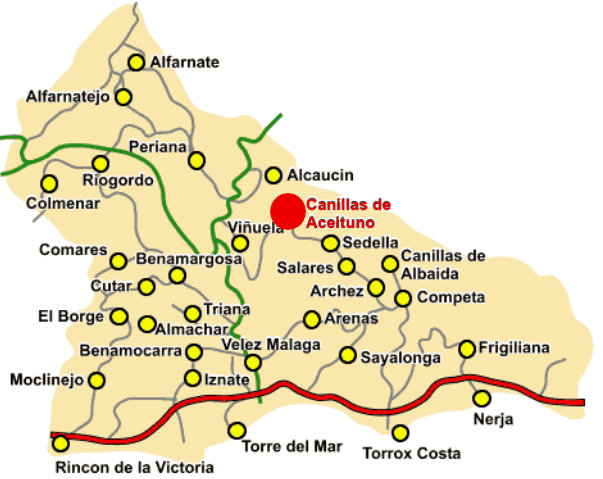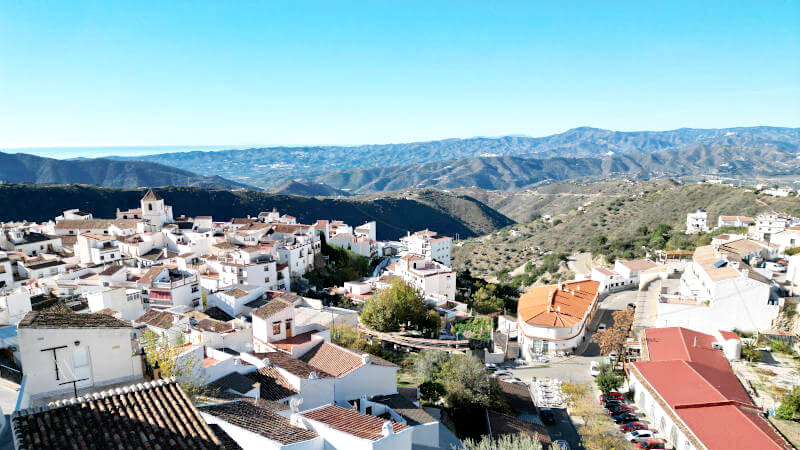-
07
jan 2019
Canillas de Aceituno
Dit witte bergdorp ligt in het oosten van de provincie Málaga en is een van de gemeenten die deel uitmaken van de comarca Axarquia en het gerechtelijk arrondissement Vélez-Málaga. Canillas de Aceituno ligt op een hoogte van ongeveer 645 meter aan de voet van de Sierra de Tejeda en wordt bekroond door de top van La Maroma op 2.068 meter, de hoogste berg in de provincie. De natuurlijke bron van La Maroma trekt mensen van kilometers ver aan omdat het gerucht de ronde doet dat het water genezend zou zijn als je het drinkt. Canillas de Aceituno grenst aan maar liefst 3 natuurparken: Sierra de Tejeda, Sierra Almijara en het Alhama Parque Natural. Vanuit Canillas de Aceituno kijk je uit op het spectaculaire stuwmeer van La Viñuela.
Het is een dorp met smalle straatjes die prachtig witgekalkt zijn, met oude Moorse bogen en bloemen en planten in elke straat. Het dorp ligt op 54 km van Málaga en 27 km van de kust bij Torre del Mar. Het is bereikbaar via de snelweg C-335 en de lokale weg M-125 vanuit Vélez-Málaga.

In tegenstelling tot wat je zou denken, heeft de naam van het dorp niets te maken met het Spaanse woord voor olijf, aceituna. De naam Canillas stamt uit de tijd dat hier veel riet groeide en komt van het Latijnse canillae (plek waar riet groeit). De toevoeging Aceituno verwijst naar de periode waarin de Moren hier zijde produceerden. Het Arabische woord voor geweven en geverfde zijde is azzeytun. Er staan nog steeds veel moerbeibomen in de omgeving, stille getuigen van de vroegere zijderupsenteelt. Vanuit Canillas liep de enige echte overgebleven Spaanse zijderoute via Alcaucín en de bergpas van Zafarraya naar het modieuze Granada, waar het hof van de Nasriden zich bevond in het wereldberoemde Alhambra.
Tegenwoordig leeft Canillas de Aceituno vooral van producten als geitenvlees (chivo), olijven, amandelen en rozijnen, die in de herfst worden gedroogd op speciale droogbedden (paseros), omgeven door ronde witte muren van pleisterwerk. En sinds enkele jaren weten ook toeristen het dorp te vinden voor wandelingen naar de top van de Maroma of El Saltillo – een soort mini Caminito del Rey – en om te genieten van een lekkere (geiten) vriendelijke maaltijd in een van de restaurants.
Door haar geografische ligging is Canillas de Aceituno een natuurlijk balkon van de Axarquía. De weg naar het dorp biedt uitzicht op de valleien van Vélez en Rubite en voert door een landschap vol olijfgaarden, wijngaarden, amandel- en vijgenbomen. Deze overvloed aan bomen is te danken aan de rivieren Almanchares, Bermuza en Rubite, die ook de natuurlijke rijkdommen zoals de Gazuela en de Ivy mogelijk maken.
In het dorp zelf zijn er twee natuurlijke bronnen die een Arabische waterput onder het gemeentehuis voeden. Een straat van archeologisch belang is de Calle Castillo, waar nog resten te vinden zijn van wat ooit een oud fort was en die via de Calle Estación naar een lager gelegen wijk leidde.
De gemeente Canillas de Aceituno beslaat een oppervlakte van 42 km². Het dorpscentrum ligt op een hoogte van 645 meter en de gemiddelde jaartemperatuur bedraagt 17 °C. Het dorp telt ongeveer 2.300 inwoners, die Canilleros worden genoemd.
Feesten
Op de laatste zondag van april wordt de kermis van Canillas de Aceituno gehouden, die samenvalt met de festiviteiten van de Virgen de la Cabeza, de patroonheilige van het dorp. In 1987 organiseerde het gemeentehuis op dat moment ook de Día de la Morcilla (de Dag van de Bloedworst), met als doel om inwoners en bezoekers te laten genieten van een typisch lokaal product. In 2004 werd dit evenement uitgeroepen tot Singulier Toeristisch Feest van de Provincie.
De bloedworst van Canillas verschilt van de normale variant doordat ze wordt bereid met uien en volgens het traditionele lokale recept. Op die dag worden er duizenden kilo’s van deze worst uitgedeeld in de straten van het dorp, samen met bier en lokale wijn, in een feestelijke sfeer die elk jaar meer bezoekers trekt.
De pelgrimstocht van San Isidro vindt normaal gesproken plaats in mei. La Lomilla is de bedevaartsplek van de heilige en de gelovigen. La Virgen de la Cabeza is ook hier weer het middelpunt van de viering.
Zoals in bijna alle Andalusische dorpen en steden wordt ook in Canillas de Aceituno de feria gehouden in de eerste week van augustus, met minstens drie feestdagen vol plezier. De festiviteiten worden begeleid door optredens en concerten, waaronder de Noche Flamenca, die een grote groep zangers en gitaristen samenbrengt. Ook sport- en vrijetijdsactiviteiten komen aan bod, met voetbal en basketbal tussen vrijgezellen en getrouwden, gratis proeverijen en een schuimfeest voor kinderen van alle leeftijden.




